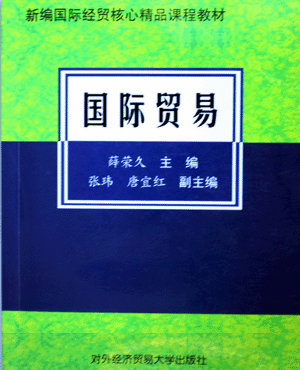| 推荐教材 |
|
Description of the main textbooks and other reference books for ITR301 course The following is a brief description of the main textbooks and other reference books that the students are supposed to refer to from time to time in the course of the lectures. MAIN TEXTBOOKS: Dennis R.Appleyard and Alfred J. Field. J r., International Economics, McGraw-Hill Companies, Inc. 2001
The book provides a clear and comprehensive text that help students move beyond simple recognition and interest in international issues and toward a level of understanding of current and future international issues which will be of use to them in analyzing the problem at hand and selecting a policy position. In other words, the book is useful in helping these students acquire the necessary skills for dealing with important questions in international trade. The author has also expended a lot of efforts stimulating the intellectual curiosity of the students and providing a necessary foundation for future on-the-job decisions. The book follows the traditional division of international economics into the trade and monetary sides of the subject. Although the primary audience for the book will be students in upper-level economics courses, the material can effectively teach a broad, diversified group of students. Moreover, throughout the text, the authors have updated information and retained features that make the book user-friendly, and the material is accessible to both non-economics and economics students. 薛荣久、张玮、唐宜红,《国际贸易》,对外经济贸易大学出版社,2006
The book written by three very experienced professors, is intended primarily for a conventional half-year course in international trade at the undergraduate level. In general, it has four features. First, the book has been used for about thirty years among in many Chinese universities. Second, the whole structure is much more complete than other similar texts, covering almost all aspects of basic trade theories and policies. Third, the contents have been periodically updated to include the latest developments in theories, knowledge and emperical findings. Fourth, the book emphasizes the balance between theory and practice, and a historical viw of international trade development. Fifth, it includes diverse schools of thought and are relevant to Chinese environments. Finally, the book is reader-friendly. Before each chapter, study goals and key points are clearly spelt out. At the end of the chapter, a summary, questions and case studies are provided. Paul R. Krugman and Martice Obstfeld, 《国际经济学》(第六版),清华大学出版社,2008 This book is to meet two challenges as perceived by the authors. The firs challenge is to communicate to students the exciting intellectual advances in this dynamic field. The second challenge is to show how the development of international economic theory has traditionally been shaped by the need to understand the changing world economy and analyze actual problems in international economic policy. The book has met the two objectives very successfully. The book attempts to provide an up-to-date and understandable analytical framework for illuminating current events and bringing the excitement of international trade into classroom. In analyzing both the real side of the subjects, the approach has been to build up, step by step, a simple, unified framework for communicating the grand traditional insights as well as the latest findings and approaches. In order to help the students grasp and retain the underlying logic of international trade, the authors motivate the theoretical development at each stage by pertinent data or policy questions. OTHER REFERENCE BOOKS James R. Markusen, James R. Melvin, Willam H. Kaempfer and Keith E. Maskus., International Trade Theory and Policy, McGraw-Hill, Inc. 1995 The book is tended to treat certain topics such as Heckscher-Olin on a fairly formal level and then resort to informal and anecdotal treatments of other topics such as scale economies, imperfect competition, factor mobility, and multinational corporations. In many of the relevant books, such topics are not treated at all. The authors have tried to use the same basic “tool kit” over and over to avoid the costs of developing and learning new analytical constructions for each new topic and the book differs significantly from its competitors on the criterion of breadth. Nicholas Lardy, Foreign Trade Reform in China: 1978-1990, Cambridge University Press 1992,? and Integrating China into the Global Economy, Brooking Institution, Washington D.C. 2002 The study explores the relationship between china’s foreign trade reforms and the domestic economic reforms that undergrids china’s policy of openness in the 1980s’ and 1990s. It examines both the external policy changes, such as the decentralization of trading authority and the devaluation of the domestic currency, and internal economic reforms such as the increased use of markets and prices that underlie china’s dramatic transformation. The author concludes with an analysis of the sources of china’s export growth and outlines further domestic economic reforms that he believes will be required to sustain china’s increasing integration into the world economy. Thomas A. Pugel,《国际贸易》(第十二版),中国人民大学出版社,2005 The book combines rigorous economic analysis with attention to the issues f economic policy that are alive and important today, it is written to be concise and readable, and uses economic terminology when it enhances the economic logic of the analysis, but avoids jargon for jargon’s sake. Some of the current and recent events that are included in this edition to provide new examples that show the practical use of our economic analysis. ONLINE LEARNING RESOURCES The WTO provides the excellent website, www.wto.org, with a great deal of information. A private website, accessible through Boalt, is www.worldtradelaw.net. It provides detailed summaries of all cases as well as easy access to the actual decisions and a variety of other useful information. Another useful site for all things related to trade is http://www.cid.harvard.edu/cidtrade/. |

